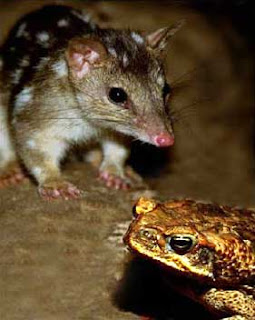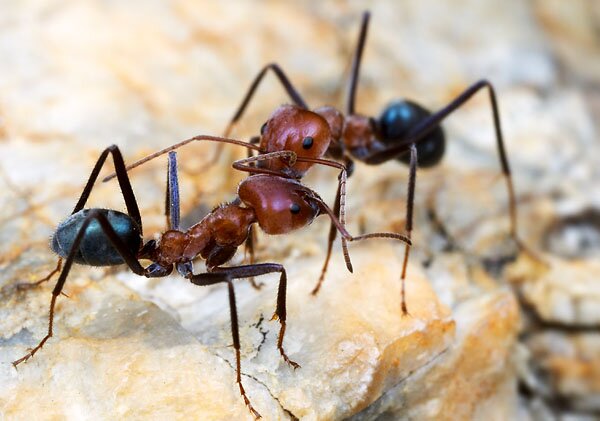 |
| Figure 1. The invasive cane toad (Rhinella marina) is widely found throughout Northern Australia. Reference: Sharon Wormleaton, Cane Toad, 2007. |
The northern quoll (Dasyurus hallacatus) located in Australia is a highly endangered species due to the invasion of the toxic cane toad. The cane toad has invaded Kakadu National Park, a conservation area in Northern Australia and as a result there was a population crash of the northern quoll. To date, cane toads have occupied 60% of quoll habitats. A taste aversion test (CTA) experiment was conducted by O’Donnell, et al., in Territory Wildlife Park where 31 juvenile quolls were fed a nausea inducing chemical called thiabendazole and 31 quolls were used as a control. It was found using the MARK program that 29 % of control quolls ate cane toads and that males were more likely to attack and eat cane toads than females. The taste aversion test is based on negative experiences that cause negative feedback, which will lead the quolls to avoid eating the toxic cane toads. While taste aversion may not be 100 % successful, scientists hope to help the quoll population remain stable.

Figure 2. The northern quoll (Dasyurus hallacatus) preys upon the the toxic cane toad (Rhinella marina).
Reference: Sharon Wormleaton, Northern Quoll - Dasyurus hallucatus, Arkive, 2007.
The cane toad uses road ways as a method of travel from one area to another and as feeding sites resulting in a large number of cane toad deaths. These flattened and dessicated toads remain extremely toxic even though they are heated to temperatures exceeding 40 degrees Celsius on a daily basis. Lab tests were conducted by Crossland, M., et al. on cane toads which produced results demonstrating that toxins in the cane toads that were "cooked" at high temperatures for several days were still active due to heat stable steroids. Normally these toxins would have degraded and lost their toxicity. Over time the cooked cane toads accumulate in the ditches that lie along the road. When the rainy seasons arrive, these usually severely dry areas flood creating hundreds of pools along the road. Consequently, toads in ditches leach toxins into the water around them. In controlled laboratory experiments, native animals such as tadpoles, fish and leeches that were in the small pools quickly died after they were exposed to the toxins. The same animals that lived in larger pools were able to retreat from contaminated areas. These experiments supported the conclusion that cooked cane toads contaminate roadside watersheds that form during the wet season. This study demonstrates how an invasive species can indirectly affect the environment in a negative way even after death.
In a study by Ward-Fear G. et al. a native species to Australia, the meat ant (Iridomyrmex reburrus) (Figure 3), was found to be able to reduce the abundance of cane toads, which in turn would reduce the negative impact the cane toads have on biodiversity. A study was conducted on the Adelaide River floodplain in the Northern Territory of Australia that found that greater than 50% of meat ant attacks on still maturing cane toads resulted in fatality and 88% of the cane toads that escaped with injuries were dead within a day. Since it was found that meat ants and cane toads share common areas within their respective habitats, baiting techniques were used to manipulate the meat ants to forage in areas that also had high densities of still maturing cane toads thus intensifying this natural predator-prey relationship. This resulted in increased interactions between the meat ant and cane toad, where 98% of metamorph cane toads were encountered and 84% of them attacked. It also made meat ants more likely to swarm cane toads larger in size. Although this technique was found to have a considerable impact on cane toad abundance and have little repercussions on surrounding fauna, it still must be integrated with other management processes.

Figure 3. A photo of the meat ant (Iridomyrmex reburrus) in Queensland, Australia.
In a study by Ward-Fear G. et al. a native species to Australia, the meat ant (Iridomyrmex reburrus) (Figure 3), was found to be able to reduce the abundance of cane toads, which in turn would reduce the negative impact the cane toads have on biodiversity. A study was conducted on the Adelaide River floodplain in the Northern Territory of Australia that found that greater than 50% of meat ant attacks on still maturing cane toads resulted in fatality and 88% of the cane toads that escaped with injuries were dead within a day. Since it was found that meat ants and cane toads share common areas within their respective habitats, baiting techniques were used to manipulate the meat ants to forage in areas that also had high densities of still maturing cane toads thus intensifying this natural predator-prey relationship. This resulted in increased interactions between the meat ant and cane toad, where 98% of metamorph cane toads were encountered and 84% of them attacked. It also made meat ants more likely to swarm cane toads larger in size. Although this technique was found to have a considerable impact on cane toad abundance and have little repercussions on surrounding fauna, it still must be integrated with other management processes.
Figure 3. A photo of the meat ant (Iridomyrmex reburrus) in Queensland, Australia.
These studies show that introducing non native species may create more problems than they solve. The introduction of the cane toad (Rhinella marina) to Australia was successful as a method of bio-control, but had unforeseen effects that negatively impacted native species.
Figure 4. The cane toad (Rhinella marina) has spread considerably since it first appeared in Australia in 1935 and is predicted to spread even more over time. Reference: Australian Government, Indicator: IW-38 Cane toad distribution, Department of Sustainability, Environment, Water, Population and Communities, 2005.
References
Crossland, M., Brown, G., Shine, R., 2011. The enduring toxicity of road-killed cane toads (Rhinella marina). Biological Invasions 13: 2135-2145.
O’Donnell, S., Webb, J.K., Shine, R., 2010. Conditioned taste aversion enhances the survival of a endangered predator imperilled by a toxic invader. Journal of Applied Ecology 47: 558-565.
Ward-Fear, G., Brown, G.P., Shine, R., 2010. Using a native predator (the meat ant, Iridomyrmex reburrus) to reduce the abundance of an invasive species (the cane toad, Bufo marinus) in tropical Australia. Journal of Applied Ecology 47: 273-280.
